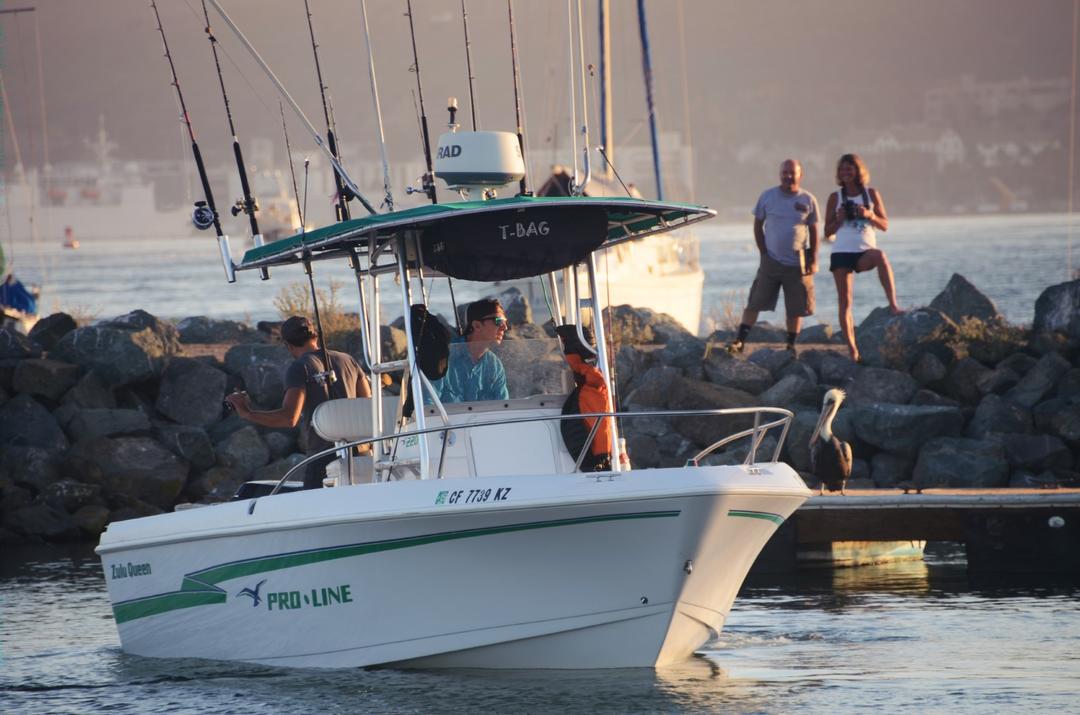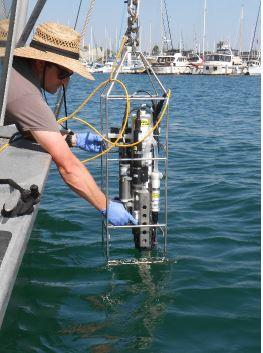Attention Boaters, Marinas, and In-Water Hull Cleaners
Final Hull Cleaning Pause Report Now Posted!
From December 19, 2021 to February 9, 2022, the Port of San Diego implemented a temporary pause on in-water hull cleaning of boats with copper antifouling paint in the Shelter Island Yacht Basin (SIYB). This in-water hull cleaning pause was in partnership with the Regional Water Quality Control Board as part of the Port of San Diego’s Copper Reduction Program and ongoing efforts to improve water quality in the SIYB. At high concentrations, copper can be toxic to marine life. Our goal is to reduce copper pollution in the SIYB by 76 percent by December 1, 2022. This reduction is required by the Regional Water Quality Control Board which has identified the SIYB as an area where high copper levels exceed federal and state standards.
The Final Hull Cleaning Pause Report includes water quality data and observations related to the in-water hull cleaning pause period and is available below. The report will help the San Diego Regional Water Quality Control Board determine what next steps are needed to achieve improved water quality in Shelter Island Yacht Basin.
For any questions, or for assistance in making an appointment to conduct any transactional business related to the In-Water Hull Cleaning Permit, please email hullcleaning@portofsandiego.org.
Frequently Asked Questions
What is the issue with copper?
Copper is an essential trace nutrient that is required in small amounts by humans, other mammals, fish and shellfish. However, at higher concentrations, copper can be toxic to sea life.
In water recreation, copper is widely used in antifouling paints for boats as the paints have been shown to effectively slow the growth and/or prevent marine organisms from attaching to the hull. This helps to not only keep the boat clean but can prevent corrosion and help a vessel’s performance, i.e., achieve maximum speeds. However, the downside of copper-based antifouling paints is that they continually release copper into the water, which can build up in and near marina waters and harm marine animals and plants. This release of copper is especially exacerbated when boats with copper-based paint are cleaned in the water – large concentrations of copper can be scrubbed or sloughed off and released into the marine environment.
How does copper harm aquatic plants and animals?
Too much copper in water can have a variety of adverse effects on sea life. For example, high copper levels can negatively impact the sense of smell in fish, which they rely on to find food, avoid predators, and migrate. In some species, too much copper has resulted in reduced sperm and egg production, or abnormalities in larval stages of certain marine life.
What is a TMDL?
A Total Maximum Daily Load is a regulatory term in the U.S. Clean Water Act describing a plan for restoring impaired waters that identifies the maximum amount of a pollutant that a body of water can receive while still meeting water quality standards. Shelter Island Yacht Basin has been identified as one of those areas where dissolved copper levels exceed the water quality thresholds and impair the beneficial uses within that water. The TMDL requires reductions of copper loading in Shelter Island Yacht Basin.
What are the current copper levels in Shelter Island Yacht Basin?
According to the Port’s most recent SIYB Annual TMDL Report (March 2021), there has been an estimated 48 percent (approximately 1,008 kg/yr) reduction in copper loading from the TMDL baseline of (2100 kg/yr) due to conversion of boats to lower copper or non-copper paints. Water quality testing shows the SIYB average to be 8.3 µg/L (California Water Quality Standards are set at 3.1 µg/L). The full report is available here.
How many boats are in SIYB?
Approximately 2,169 total vessels are in the Shelter Island Yacht Basin, about 2,051 of which have copper-based paints. Approximately 118 have been reported that do not have copper antifouling paint.
What has been done so far?
The Port has converted all boats in our fleet to non-copper, non-biocide hull paints early in the TMDL. The Port continues to maintain a copper-free fleet which does not contribute any copper into the SIYB. The Port also provides regular education about the regulations and water quality to the boating community in Shelter Island and around the bay. The Port also conductive extensive research on alternative (non-copper) paints and assisted the SIYB boaters in voluntary hull paint conversion through the assistance of a state grant. Additionally, the Port embarked on an outreach campaign to raise awareness of and increase the use of alternative (non-copper) hull paints.
Copper Reduction Program
The Port of San Diego is a regional leader in improving water quality in San Diego Bay. Through the Copper Reduction Program, the Port is engaging with the boating community to reduce levels of dissolved copper in marina basins around the bay as it can be harmful to marine animals and plants.
The Port’s Copper Reduction Program focuses on the largest source of copper - boat hull paints - and identifies an approach to improve water quality and achieve compliance with regulations while balancing economic and public interests. The Board of Port Commissioners Resolution (2009-230) champions copper reduction as part of its environmental stewardship mission.
In San Diego Bay, Shelter Island Yacht Basin (SIYB) has been identified as an area where high copper levels exceed federal and state standards. A regulatory order requires the Port of San Diego, marinas, yacht clubs, hull cleaners and boaters to reduce copper pollution in this area by 76 percent by 2022. Together with the boating community, we’ve reduced copper loading in SIYB by 45 percent to improve water quality.
The Dissolved Copper Water Quality readings show regulatory listings for water body impairments around San Diego Bay. Below is a recent assessment of copper levels in San Diego Bay:
The Port's Copper Reduction Program focuses on:
- Policy development and legislation related to in-water hull cleaning and hull paints
- Conducting site-specific and baywide monitoring
- Encouraging hull paint conversions
- Conducting hull paint testing and research
- Conducting community outreach and engagement
In-Water Hull Cleaning Policy Development
The Port of San Diego adopted In-Water Hull Cleaning regulations in 2012 to reduce or eliminate copper pollution caused by hull cleaning activities in San Diego Bay. The ordinance requires the use of Best Management Practices (BMPs) for anyone doing in-water hull cleaning. The In-Water Hull Cleaning Permit is a bay-wide permit that all businesses must obtain prior to conducting in-water hull cleaning services.
In late 2019 into early 2020, Port staff conducted outreach and engaged with the boating community regarding proposed amendments to the Port's proposed ordinance for in-water hull cleaning. To view all supporting documents and resources,click here. To access comments received during the draft ordinance public comment period,click here. The Port appreciates the engagement and comments received on the this topic. Port staff continues to evaluate the feedback and potential next steps.
The Ordinance (amended in 2021)
|
The Permit
|
*The Port is currently reviewing and seeking to update existing policies related to in-water hull cleaning. Until the review is complete, please send any inquiries regarding obtaining or renewing a permit to hullcleaning@portofsandiego.org.
Legislation Support
One of the goals of the Copper Reduction Program is to promote regulatory change at the state level and to develop local policies, procedures or permits to address copper pollution. Over the past several years, the Port has supported multiple state representatives and their regulations that impact the water and air quality.
- Senate Bill 623 (Suspended in 2012) to eliminate copper in marine antifouling paint
- Assembly Bill 425, related to registering copper-based antifouling paint
- Senate Bill 346, related to removing copper in automotive brake pads
- Department of Pesticide Regulation on Copper-based Antifouling Paints
The Board of Port Commissioners has also:
- Supported the California Environmental Protection Agency Department of Pesticide Regulation's re-evaluation of hull paints;
- Approved the Port's environmental department receiving a $180,000 grant from the Environmental Protection Agency to study alternative paints;
- Approved a State 319h grant for $600,000 to assist boaters in switching from copper-based hull paint to a non-copper alternative;
- Approved three grants totaling $230,000 through the Port's Environmental Fund for outside parties to develop alternative hull paints; and
- Approved projects aimed at reducing copper in water through the Blue Economy Incubator.
In-Water Hull Cleaning Survey
As part of our Copper Reduction Program, the Port of San Diego invited boaters, hull cleaners, and marina and yacht club operators and managers in the San Diego Bay boating community to participate in our In-Water Hull Cleaning Survey to help the Port better understand how vessels are being cleaned.
Thank you to all who took the time to complete the survey! We received approximately 450 responses.
The Port has compiled the data in a series of graphs and figures for the responses provided and is pleased to share the findings with you. Please find posted below the graphical summaries by survey group (boaters, hull cleaners, and marina and yacht club operators and managers).
The Port will be using the information to better understand the cleaning strategies used in San Diego Bay and inform potential next steps in our collective effort to improve water quality.
IWHC Boater SurveY RESULTS IWHC Hull Cleaner Survey Results IWHC Marina Survey Results
Hull Paint Conversion
Converting to non-copper hull paint is foundational to the Port’s Copper Reduction Program. Reducing the use of copper hull paint - a major source of copper pollution in marina basins - will help improve water quality.
The Port is helping to spread awareness of non-copper alternatives by funding research projects, testing non-copper hull paints in San Diego Bay, and developing outreach materials and tools.
Leading By Example: The Port has converted all boats in its fleet to non-copper hull paints. The fleet includes both Harbor Police boats and General Services work boats.

Alternative Hull Paints
Copper from anti-fouling hull paints can be a significant source of water pollution in marina basins. Copper harms marine life by impeding or altering their development. As a result, boaters are encouraged to consider converting to alternative hull paints that are better for the environment.
The Environmental Protection Agency provided funding for the Port of San Diego to conduct a study that evaluated a variety of alternative hull paints. The three-year study, “The Safer Alternatives to Copper based Antifouling Paints,” evaluated a variety of alternative hull paints. Twenty-one of these paints performed well when compared to copper hull paints and 11 were further tested in real-life scenarios on boats. The study concluded that alternative hull paints are environmentally-friendly, cost-effective and are an effective replacement.
Helpful Tools for Boaters
Boater’s Guide to Choosing Hull Paints in California
Boater Testimonials
Read what San Diego boaters have to say about their experience with eco-friendly paints.
|
“I get underway about twice a month, I bring the boat up to its cruising speed for a few minutes, which I’m normally doing in my operation anyway, and all the marine growth flies off the bottom of the boat.” ~ Todd Roberts (Bottomspeed) |
“The cleaning has been cut down…some boats it would take three hours to clean…and now… we can get in there and clean it in fifteen to twenty minutes. I can just use my glove to clean it. I can actually just use a glove!” ~ Thomas Hahn (Intersleek 900) |
To join the mailing list for In-Water Hull Cleaning and copper-related information, click here.


